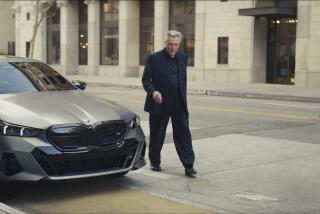Ads on Videotape Are Catching On
- Share via
Nearly 100 New Yorkers have eagerly sent $9.95 each to American Isuzu over the last few weeks. They weren’t buying specialized windshield wiper blades--or Joe Isuzu-autographed litter bags.
They were paying for advertisements.
Specifically, they shelled out nearly 10 bucks each for detailed, videotaped advertisements about Isuzu’s upscale car, Impulse. And similarly, about 300 people have sent $12 each to the Irish Tourist Board for a lengthy video ad on Ireland. And nearly 5,000 people have sent their $5.95 to Royal Silk for videotaped catalogues of their silk blouses.
At first blush, it might seem loony for clear-thinking individuals to pay money for ads on tape. After all, people can plop down in front of their TV sets and watch all the ads they want for free. But advertisers are just beginning to discover that there are wealthy people out there who--hoping to save time--will pay to receive advertising.
“All I’m trying to do is get someone out of their home and into the dealership,” said Leon Rosen, national marketing director at American Isuzu. “This tape gives someone enough ammunition to walk into the dealership and say, ‘OK, I’ve seen the car, now I’d like to take it for a test drive.’ ”
But the Isuzu tape--which cost $150,000 to produce--hardly looks like a commercial. In fact, it’s a glitzy mini-movie about a stunt driver and his female boss who fall in love with their Isuzu Impulses--and with each other. The romantic adventure details features of the sporty car.
Companies are already sprouting up that specialize in packaging these video ads. “After all,” said Cherri Briggs, president of the Century City-based firm, Direct Impact Video Inc., “this is a TV culture that we are living in.” Indeed, nearly 40% of all U.S. homes have VCRs--and that figure continues to rise. Video ads are achieving some success, too. Since Royal Silk began placing items in video ad catalogues last year, the average order has jumped to $100 from $60, said Gerry Pike, vice president of the firm. And one cruise ship operator, Royal Viking Line, has sold thousands of videotaped cruise ads over the last few years--at $9.95 each. “It’s really no different than paying for catalogues,” said Marketing Director Joe Garvey, “and plenty of people do that.”
Slightly less enthusiastic, however, is Simon O’Hanlon, ad manager for the Irish Tourist Board. His group has only sold 300 of its 1,000 copies of videotaped ads about travel in Ireland. It seems that a portion of the video ad features dancing in a Dublin disco. “We got one angry letter from a women’s church group who didn’t find this suitable,” O’Hanlon said. “Consumers seem to react differently when they pay for ads than when they don’t.”
Companies Spending Less on Advertising
Once again, Procter & Gamble appears to be the ad industry’s best friend.
The Cincinnati-based packaged goods firm ranked as the nation’s biggest advertiser in 1986, according to the trade publication Advertising Age. It marked the 23rd year in a row that Procter & Gamble--maker of Tide, Ivory soap, Pampers and more--topped the list of the nation’s 100 leading advertisers.
But the magazine reported that P&G;’s U.S. ad spending fell a startling 10.3% last year. While P&G; refused to comment on the Ad Age report, a company spokeswoman said P&G;’s worldwide ad budget in the 1986 fiscal year (ended June 30, 1986) actually jumped more than 20%, compared to the year before.
But Ad Age sticks with its figures. “They (P&G;) toss everything but the kitchen sink into those numbers,” said R. Craig Endicott, special issues editor. “We just compute real advertising dollars.” The Top Five ad spenders in 1986 according to Ad Age:
1) Procter & Gamble Co., $1.435 billion, down 10.3%.
2) Philip Morris Cos., $1.364 billion, up 0.4%.
3) Sears, Roebuck & Co., $1.004 billion, up 25.6%.
4) RJR Nabisco, $935 million, up 6.2%.
5) General Motors Corp., $839 million, up 7.7%.
How Do You Say Obnoxious in Spanish?
If Jacko drives you nutso in English--wait’ll you hear him in French and Spanish.
If the name’s not familiar, Jacko--short for Mark Alexander Jackson--is that Australian bloke who has been hyping Eveready’s Energizer batteries on television for the past three weeks. Decked in an Energizer muscle shirt, he shouts: “It’ll surprise ya, new Energizer.”
After the campaign broke in Australia last year, sales of the batteries there jumped 40%. In New Zealand, sales rose 30%. With that ammunition, Eveready has decided to release Jacko in North America in a multitude of languages. A French version of the ad will begin airing in Montreal next week. The Spanish version--which will be broadcast in U.S. Spanish-speaking markets--hasn’t been filmed yet.
There is one small problem, however. Jacko doesn’t speak Spanish. “But if I make the effort,” Jacko said in an interview, “they’ll appreciate a bloke who makes a go of it.”
Although Jacko is a relative newcomer to the U.S. market, he’s well-known in Australia, where he’s had two hit records and played football for several years. He recently signed a three-year contract with Eveready. “I can fit three batteries in my mouth at once,” Jacko said. “Where else do you think I get all my energy?”






